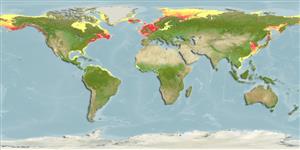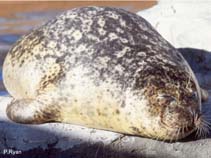Phoca vitulina Linnaeus, 1758
Harbour seal| Native range | All suitable habitat | Point map | Year 2050 |

|
| This map was computer-generated and has not yet been reviewed. |
| Phoca vitulina AquaMaps Data sources: GBIF OBIS |
Classification / Names Common names | Synonyms | CoL | ITIS | WoRMS
| Carnivora | Phocidae
Environment: milieu / climate zone / depth range / distribution range Ekologi
Djupbottenlevande. Temperate; 90°N - 0°S, 180°W - 180°E
Utbredning Länder | FAO områden | Ekosystem | Förekomster | Utplanteringar
Atlantic Ocean, Pacific Ocean, the Arctic and North America Inland Waters: Portugal, Iceland, Greenland, Canada Newfoundland, Spain, France, Belgium, Ireland, Netherlands, Germany, Denmark, Norway, Sweden Lithuania, Poland, Latvia, Estonia, Finland, Russia, UK, USA, Canada, Mexico, Alaska, Japan, Kamchatka (Ref. 1394), Br Scotland, Madeira, British Columbia, Kuril Island, Sea of Okhotsk, Gulf of California, Baltic Sea, Barents Sea, Hudson Bay (Ref. 1522); Phoca vitulina vitulina: Portugal, UK, Iceland, Greenland, Br Scotland, Norway, Madeira, Baltic Sea, Barents Sea; Phoca vitulina concolor: Canada, Hudson Bay, USA, Greenland, Iceland; Phoca vitulina richardii: Mexico, Alaska, British Columbia, USA, Gulf of California; Phoca vitulina stejnegeri: Japan, Kamchatka, Alaska, Sea of Okhotsk, Kuril Island; Phoca vitulina mellonae: Hudson Bay, James Bay. Temperate to polar regions.
Length at first maturity / Size / Vikt / Age
Maturity: Lm ? range ? - ? cm Max length : 190 cm TL hane/ej könsbestämd; (Ref. 1394); 170 cm TL (female); publicerad maxvikt: 150.0 kg (Ref. 1394); publicerad maxvikt: 150.0 kg
Found in coastal waters of the continental shelf and slope (Ref. 1394); and whelp in groups on beaches, sandbars, and rocky reefs (Ref. 1522). Feeds on a wide variety of fish, cephalopods, and crustaceans of surface, mid-water and benthic habitats (Ref. 1394). It is preyed upon by the great white shark (Ref. 32140). Found in coastal waters of the continental shelf and slope (Ref. 1394); and whelp in groups on beaches, sandbars, and rocky reefs (Ref. 1522). Also for resting, moulting and lactation during low tides. Typically perform U-shaped dives. Leave the coast on foraging trips to deeper offshore waters where prey is abundant (Ref. 96347). Feeds on a wide variety of fish, cephalopods, and crustaceans of surface, mid-water and benthic habitats (Ref. 1394).
Life cycle and mating behavior Könsmognad | Reproduktion | Lek | Ägg | Fecundity | Larver
Main reference
referenser | Koordinator | Medarbetare
Jefferson, T.A., S. Leatherwood and M.A. Webber. 1993. (Ref. 1394)
IUCN Red List Status (Ref. 130435)
Least Concern (LC) ; Date assessed: 04 January 2016
CITES status (Ref. 108899)
Not Evaluated
CMS (Ref. 116361)
Appendix II: Migratory species conserved through agreements
Threat to humans
Human uses
Fiskeri: kommersiell
FAO - fiskeri: landings, species profile | FishSource | Sea Around Us
Verktyg
Ytterligare information
Internet-källor
BHL | BOLD Systems | CISTI | DiscoverLife | FAO(fiskeri: species profile; publication : search) | Fishipedia | GenBank (genome, nucleotide) | GloBI | Gomexsi | Google Books | Google Scholar | Google | PubMed | Tree of Life | Wikipedia (Go, sök) | Zoological Record
Estimates based on models
Preferred temperature
(Ref. 115969): 3.4 - 11.2, mean 8.7 (based on 1375 cells).
Resiliens
(Ref. 69278):
Mellan, lägsta populationsfördubblingstid 1,4-4,4 år (K=0.09-0.4).
Price category
(Ref. 80766):
Unknown.



